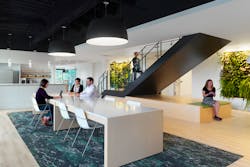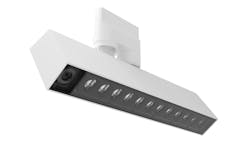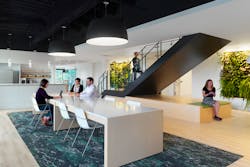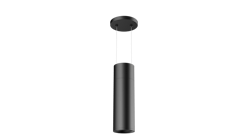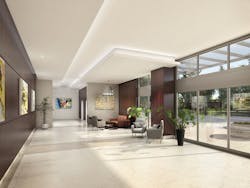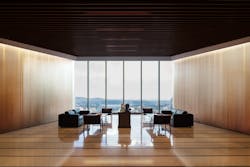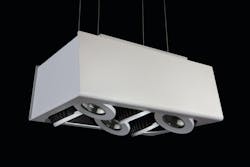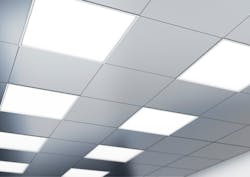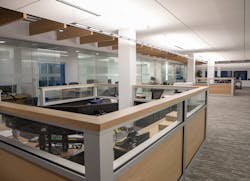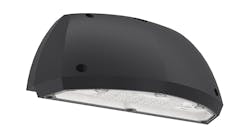We opened the year 2020 calling for a renaissance in solid-state lighting (SSL) where quality trumps efficacy and where the industry moves free of legacy form factors and truly leverages the LED source. A pandemic may have gotten in the way, but prior to COVID-19 the industry was progressing nicely and indeed, even in the teeth of the coronavirus scare, we have seen advancements in quality at the LED and luminaire level. MAURY WRIGHT explores a sample of new luminaires that provide a hint at the evolved thinking of product developers and a nudge to the imagination of lighting designers/ specifiers. Even in a year where major lighting tradeshows have been cancelled and business practically ground to a halt, innovators must search for new approaches to indoor architectural lighting.
Glint Lighting Hero with Light Shift technology
At first glance, the Hero luminaire seems rather ordinary. A product photo doesn’t readily reveal innovation in form or function. But the operational aspects of the luminaire has won Glint Lighting multiple awards, and most significantly an LEDs Magazine Sapphire award earlier this year. The design combines excellent optics that eliminate glare while offering a series of tightly controlled beams. Moreover, Glint developed a simple method that designers/specifiers can use to individually aim each SSL element integrated into a luminaire. The adjustment is a mechanical process, but a very simple one contained entirely inside the luminaire. It leverages what the company calls Light Shift technology. Furthermore, the mechanism that directs the beam is completely hidden. The individually adjustable light elements within the luminaire aren’t angled in different directions on visible gimbals and the design eliminates the cluttered look on many ceilings in retail, museum, and similar settings. And ultimately the luminaire can be mounted in a suspended configuration or hidden in a recess. Hero is an excellent example of a product that delivers quality light and that can almost disappear in plain sight. The adjustable concept will also reduce installation cost and enable repurposing of luminaires easily when changes are made in a space.
Eureka Lighting Aperture
Hiding light fixtures from view is one angle toward sleek lighting design for commercial spaces, and a good one. But the opposite approach also works well. You can make the luminaire a part of the overall architectural concept in a space. Eureka Lighting (an Acuity Brand) takes the latter approach with the design of many of its luminaires. Take the Aperture suspended pendant as an example. The large but subtle form is almost like a piece of furniture in a space. Consider the case study we published earlier this year about new lighting at TriHealth offices in Cincinnati, OH. Architects at GBBN used Aperture luminaires to define communal meeting spaces in the office. Still, there is a lot of innovation in the Aperture design. Eureka developed a circular light engine that is completely hidden inside the drum-like structure of the luminaire. Even people directly under the luminaire would not see the LED sources. The effect is glare free and uniform light controlled by the inner surfaces of the drum structure. Meanwhile, Aperture affords architects and interior designers many options in size and color. There is dimming support and some choice of CCTs in the warm range.
Meteor Lighting Duo up/down cylinder
The cylindrical form for a luminaire is not a new concept. But the Meteor Lighting Duo luminaire certainly leverages LED sources in ways that legacy sources would simply not support. At the same time, Duo supports the established trend of layered lighting delivering indirect uplight to reflect from the ceiling and direct downlight for task or accent functionality. Back to the advantage of SSL technology, the LED-based Duo allows designers/specifiers to hide the driver in the ceiling or wall. DC power comes to the luminaire via the simple cables that also suspend the pendant. Meteor further has developed tunable-light options for the product family. You can specify tunable-white capability for both the direct and indirect elements with separate adjustability and dimming for each. And the company offers a tunable-color (or RGB — red, green, and blue) option for the indirect element. The luminaire design earned a score of 4 Sapphires in our 2020 Sapphire Awards program, barely missing out on finalist status. Indeed, that score would have been recognized in the finalist class in other years and/or categories. Meteor says the product is the only 4-in. cylinder that can deliver 4300 lm from the downlight element.
Winona Wincove cove lighting
Cove lighting is a key element of a layered lighting approach, especially in commercial spaces. Such lighting is discreet and it can fill needs including a direct accent layer and/or an indirect ambient layer in a space. Often, however, it’s not the actual lighting design relative to cove products that is a problem. Rather it’s the issue of installation and customizing the installation to the dimensions of the space at hand. Winona (an Acuity Brand) sought to simplify the specification and installation process with the new Wincove design. The company refers to the product as “integrated and prefabricated.” Those words acknowledge that much cove lighting is essentially fabricated on the job site from LED strips, independently purchased drivers, and standard off-the-shelf extrusions. Wincove comes with all of the above integrated in 2-, 3-, and 4-ft lengths. The products can be easily daisy chained to minimize the need for power runs. And buying the integral luminaire means that specifiers get access to a choice of asymmetric or lambertian optics. The products use Acuity’s eldoLED driver for precision dimming and can be specified with a variety of control options including the nLight wired and wireless schemes.
A-Light WGD9 wall grazer
One tried and true method for hiding the origin of light is wall grazing. You can accomplish the effect with clearly visible fixtures very easily because such fixtures can be mounted well away from the wall upon which gentle uniform light is desired. You can also hide such fixtures in a cove, at the top of the wall, for instance, and the engineering and design problems become more arduous. A-Light developed the WGD9 for just such applications. The luminaire outputs a very narrow 7° beam. The design can deliver 545–1091 lm/ft in a typical installation. That output and the narrow beam means that you can graze a 20-ft-high wall with the product and achieve worst case 8:1 uniformity. The company says that it engineered the optics to highlight surface textures on a wall while eliminating hot spots and dead zones. Designers/specifiers also have options in terms of quality of light. A-Light does offer a 90-CRI version. The WGD9 luminaire was also entered in our Sapphire Awards program this year and earned a judges’ score of 3.75 Sapphires.
Luminis Multilux high-bay luminaire
High-bay applications aren’t typically the place you would look for innovation in form or function in terms of luminaire design. And indeed the primary mission of a lot of high-bay lighting is delivery of enough lumens to support the application at hand. These products are used in a broad set of environments ranging from big-box retailers to airports to auditoriums to convention centers and more. Luminis (an Acuity Brand) believes, however, that many applications demand more than a simple design that uniformly spreads a big lumen package over a space. The Multilux Series offers plenty of output power spanning to 22,000 lm over five multi-head configurations. The product family includes as many as six heads or LED illumination elements in a 2×3 configuration down to models with a single head. The true strength of the product family is flexibility. Each head can be equipped with a variety of beam-shaping optics ranging from 9° narrow beam with a cutoff reflector option to 15° narrow reflector to 30° flood to 52° wide. Moreover, the heads can be rotated or tilted. And optics along with mechanics are independent for each head, enabling a mix of use-case support in one luminaire. The Multilux is another product that was entered in our Sapphire program for 2020, earning 3.5 Sapphires.
Columbia Lighting planar troffer
Now let’s turn to office lighting in commercial spaces. Offices have traditionally been poorly lit with fluorescent troffers even as some of the most valuable personnel in companies toiled under that lighting. We’d love to see an all new approach to office lighting, but old habits, and economical ones, die hard so we will take advancements where we can get them. A vast improvement in troffer-like recessed fixtures can be realized with planar LED lighting that uses a light guide or diffuser optic to generate uniform illumination. Columbia Lighting (a Hubbell brand) recently announced three such products in the CBT, Scaler, and CFP luminaire series. The three product families run the gamut of technologies. The CBT employs direct LED backlights behind the diffuser and therefore is deeper essentially mandating recessed mounting. The Scaler uses edge-lit optics and is a much thinner product that can be surface mounted. Moreover, the premium member of the trio includes white-point tunability as an option and Hubbell NX Distributed Intelligence wired and wireless control options. The CFP is also edge lit with 0–10V controls.
Zumtobel Clean II planar luminaires
We’ve seen a rapid expansions of planar lighting products in the last few years, and a corresponding expansion of the application space in which the products can be utilized. Zumtobel, for example, offers a number of planar products, but the company has recently announced a second generation of Clean series products that are specifically designed for applications in cleanrooms, medical facilities, food production, and more. The new Clean II products include a variety of specialty features attuned to the applications listed previously. For example, the products are available with what Zumtobel calls actively controllable light. The feature is white-point tuning with some new angles. The intent ranges from circadian health and wellbeing for patients in a medical setting to high-fidelity white light for doctor exams to blue-or-green-tinted emission for workers that need visibility in darkened spaces. The products also have features that simplify snap-in installation in areas such as cleanrooms. Even the optics utilized have multiple application-centric angles. Zumtobel says that the micro-pyramidal optic that it calls MPO+ ensures the best possible light under which doctors can examine patients.
Acuity Olessence OLED luminaire
In conclusion, let’s go back to the future or something of the sort. When we last did an indoor luminaire story such as this, we led with the Acuity Olessence OLED luminaire. It combines inherently uniform and glare-free OLED downlight with LED indirect uplight. Alas, the last four years haven’t been great for OLED technology. The technology has continued to lose ground to LED-based planar lighting in terms of cost, performance, reliability, and more. Most of the SSL industry has moved away from OLED technology except in very niche applications. The US Department of Energy does continue to push research on OLEDs both funding industry R&D and conducting research on available products. Acuity has remained an OLED supporter and recently relaunched Olessence. There have been a number of minor refinements. The biggest change has been the OLED panel maker. LG is no longer making OLED panels for general lighting applications. Acuity is now partnered with OLEDworks, which includes the former Philips OLED unit and technology.
For up-to-the-minute LED and SSL updates, why not follow us on Twitter? You’ll find curated content and commentary, as well as information on industry events, webcasts, and surveys on our LinkedIn Company Page and our Facebook page.
